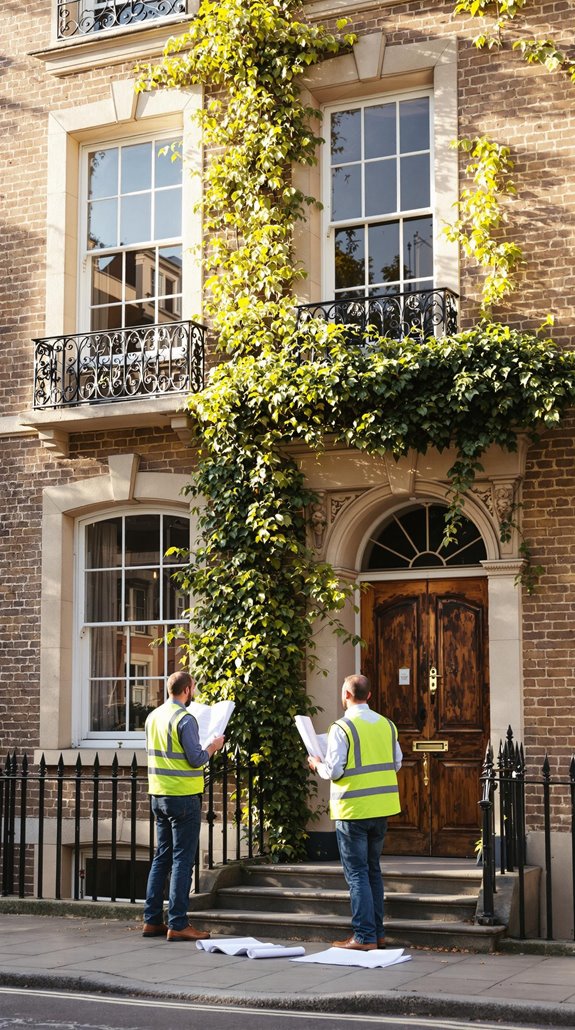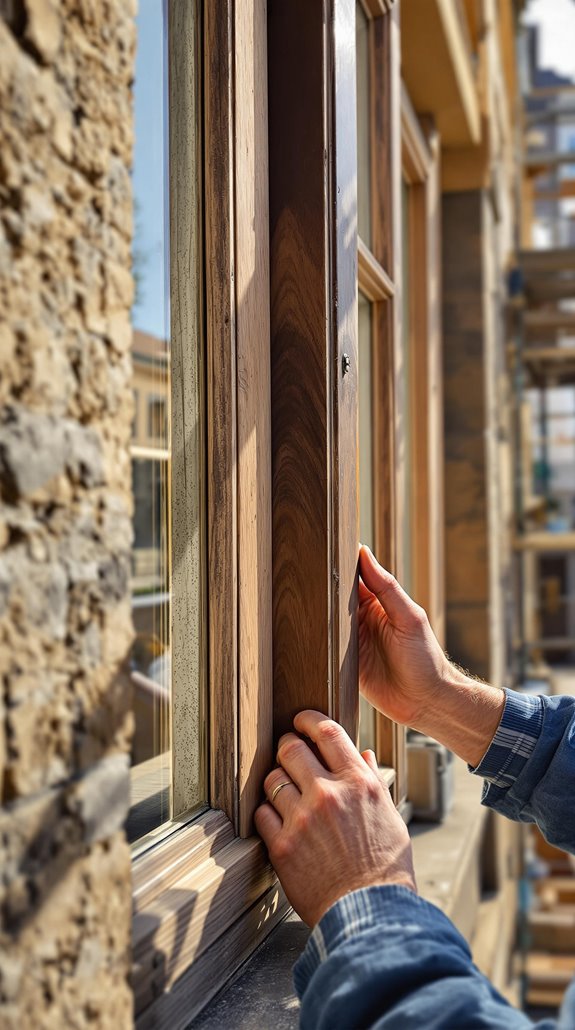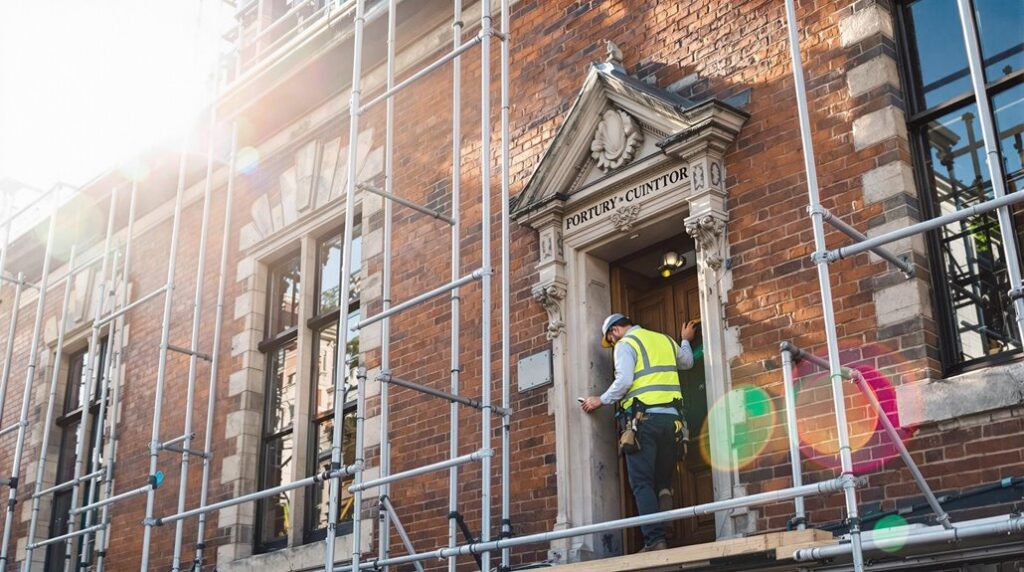If you’re planning to renovate a listed building, I’ll be straight with you—one wrong move could land you in serious legal trouble. The rules aren’t just suggestions; they’re strict legal requirements that can result in hefty fines, court orders, and even criminal charges if you get them wrong. Before you pick up that sledgehammer or start ripping out original features, there’s essential information you need to understand about what’s allowed and what isn’t.
Key Takeaways
- Always obtain listed building consent before making alterations affecting architectural or historic interest to avoid criminal prosecution.
- Routine maintenance and minor interior changes not affecting special features can proceed without consent from authorities.
- Engage conservation officers early through pre-application consultations to understand what work requires formal approval.
- Prepare detailed heritage statements and method statements demonstrating how proposals preserve the building’s special character.
- Allow officer inspections during construction and submit material samples for approval to ensure ongoing compliance.
Understanding Listed Building Grades and Their Restrictions

When you’re dealing with a listed building, understanding its grade determines exactly what restrictions you’ll face during renovation. Grade I buildings represent the most exclusive category—just 2.5% of England’s listed structures—and require consent for even minor internal changes. You’ll encounter the strictest controls here.
Grade II* buildings fall into the middle tier at 5.8% of listings, demanding high scrutiny for works affecting their “more than special interest” elements. Grade II dominates at over 90% of listings, but don’t assume it’s easier—you’ll still need consent for alterations affecting special interest features. These buildings provide essential insights into local history and culture, forming the backbone of England’s architectural heritage.
In Northern Ireland, Grade A buildings mirror Grade I restrictions. Remember, unauthorized work triggers criminal charges regardless of grade, so I always recommend securing proper consent before starting any modifications.
When You Must Apply for Listed Building Consent
Listed building consent becomes mandatory whenever you plan alterations that could affect the building’s special architectural or historic interest. This requirement covers virtually any change beyond ordinary maintenance.
You’ll need consent for demolition, structural alterations, extensions, and changes to historic features like original windows or fireplaces. Internal works affecting room layouts or architectural elements also require approval. The rules extend to attached structures and pre-1948 buildings within your curtilage. Additionally, it’s essential to consider how your renovations may impact inclusive design principles that promote accessibility for all.
There’s no minimum threshold – even minor changes like replacing a window with different glazing patterns need consent. What constitutes “ordinary maintenance” versus alteration can be unclear, so I recommend consulting your local conservation officer before starting any work. The quickest application method is online submission. Unauthorized alterations constitute criminal offenses regardless of scale.
Like-for-Like Replacement Requirements and Materials

The golden rule of like-for-like replacement demands exact replication of your building’s original features in every detail. I can’t stress enough how essential material matching is—timber must replace timber, never uPVC or aluminum. You’ll need to replicate identical glazing patterns, moulding profiles, and opening mechanisms that preserve your building’s historical character.
If your windows have historic glass, you must use handmade cylinder glass replication. Modern materials are strictly prohibited and will trigger consent requirements. Your glazing thickness, distortion, and color must match original properties precisely.
Remember that window repair may not require consent, making it the preferred first option before considering replacement. Regular maintenance and repair of original windows should always be your priority, as replacement is only permitted when windows are completely beyond salvage.
Renovation Work You Can Do Without Consent
How much renovation work can you actually undertake without the bureaucratic hurdle of listed building consent? You’ll be relieved to know there are several areas where you can proceed without formal approval.
Routine maintenance forms the backbone of acceptable work. This includes essential upkeep that preserves your building’s existing character without alteration. You can also tackle minor interior changes that don’t affect the building’s special architectural or historic interest. Engaging in these practices helps to ensure the building remains true to its historical significance.
Emergency repairs represent another vital exception. When urgent structural issues threaten your property’s safety or integrity, you’re permitted to act swiftly without waiting for consent.
Interior redecoration projects such as repainting or wallpapering generally fall within the scope of permitted work without requiring formal consent.
The key principle governing all these exceptions is maintaining authenticity. Your work must preserve the building’s historic fabric and character while addressing practical needs through careful, sympathetic approaches.
Hiring the Right Specialists for Your Project
Success in listed building renovation depends heavily on assembling the right team of specialists who understand heritage construction inside and out. I can’t stress enough how vital it is to hire contractors with proven experience in conservation work and a portfolio of successful heritage restorations.
Look for specialists who demonstrate deep knowledge of traditional materials like lime mortar and imperial bricks, plus mastery of techniques such as timber framing and lath-and-plaster restoration. They should understand grade-specific regulations and have experience preparing Listed Building Consent applications.
The right team will take a consultative approach, transparently communicating about feasibility and constraints while coordinating with heritage architects when needed. They’ll prioritize preserving original fabric and provide post-project maintenance guidance for longevity. Additionally, ensure your specialists can work effectively with conservation officers throughout the project to maintain compliance and achieve the best preservation outcomes.
Enforcement Actions and Legal Consequences
When unauthorised work occurs on a listed building, the consequences extend far beyond simple planning violations. I’ll explain what you’re facing if you proceed without proper consent.
Criminal prosecution can result in two years imprisonment and unlimited fines. There’s no defence for ignorance of listed status, and retrospective consent won’t protect you from criminal liability. The courts will consider any financial benefits you’ve gained from the offence.
Local authorities can issue enforcement notices requiring you to restore or mitigate unauthorised works. You’ll inherit liability for previous owners’ breaches, and there’s no time limit for enforcement action. In extreme cases, authorities may seek injunctions to halt ongoing unauthorized works or prevent further degradation of the building.
Unlike standard planning breaches, listed building violations create perpetual liability. Authorities can prosecute decades after the breach occurs, even after granting retrospective consent.
Working With Conservation Officers and Local Authorities
Given these serious legal risks, your best strategy is building strong working relationships with conservation officers and local authorities from the project’s outset. I recommend starting with pre-application consultations where you’ll submit informal proposals and receive early feedback on feasibility. You’ll need detailed historical documentation, site photographs, and heritage statements during these discussions. Additionally, understanding barn planning permission can significantly aid in the conversion process.
When preparing statutory applications, include heritage impact assessments and method statements emphasizing reversible techniques and traditional materials. Don’t hesitate to engage conservation officers in site meetings to resolve complex challenges—they’re invaluable allies who can connect you with specialist craftsmen. Conservation officers work with multi-disciplinary teams alongside specialists like archaeologists to ensure comprehensive heritage protection.
Throughout construction, allow officer inspections during critical phases and submit material samples for approval. This collaborative approach guarantees compliance while protecting our shared heritage.
Essential Documentation and Compliance Strategies
While building positive relationships with conservation officers provides the foundation for successful listed building projects, you’ll need thorough documentation and robust compliance strategies to navigate the formal approval process effectively.
I’ll guide you through the essential documentation that strengthens your Listed Building Consent application. You’ll need detailed plans, extensive heritage statements, and evidence demonstrating how your proposals preserve the building’s special interest. For complex projects, include method statements outlining conservation techniques and work sequences. Additionally, ensure that your plans comply with building regulations to avoid potential legal issues during renovations.
Your compliance strategy should align with the National Planning Policy Framework, emphasizing historical preservation while accommodating sensitive modern alterations. Engage heritage specialists early, conduct thorough research into your building’s significance, and use traditional materials wherever possible. Document everything meticulously—this evidence supports your application and demonstrates your commitment to preserving our shared architectural heritage. Remember that decisions are typically expected within 8 weeks of submitting your application to the local planning authority.
Conclusion
I’ve covered the essential legal framework you’ll need to navigate when renovating a listed building. Remember, it’s always better to seek consent when you’re unsure rather than face enforcement action later. Start conversations with conservation officers early, maintain detailed documentation, and don’t cut corners on materials or specialists. Following these rules isn’t just about avoiding penalties—it’s about preserving our architectural heritage for future generations while creating your dream home.
References
- https://www.insuremy.co.uk/guides/guide-to-renovating-listed-buildings-in-the-uk
- https://www.jamesclague.co.uk/news/listed-building-renovation-and-refurbishment-a-guide
- https://www.saundersbrothers.co.uk/post/listed-building-renovation
- https://www.gov.uk/government/publications/the-upkeep-and-repair-of-historic-buildings/the-upkeep-and-repair-of-historic-buildings
- https://www.squarepointsurveyors.co.uk/blog/listed-building-renovations-what-you-need-to-know/
- https://www.cia-landlords.co.uk/faq/what-are-the-different-categories-of-listed-buildings/
- https://en.wikipedia.org/wiki/Listed_building
- https://www.london-law.co.uk/listed-buildings-guide/
- https://historicengland.org.uk/advice/your-home/owning-historic-property/listed-building/
- https://www.manchester.gov.uk/info/514/listed_buildings_register/1906/what_is_a_listed_building

